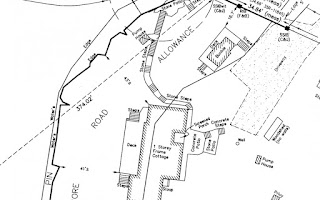Search This Blog
Most Popular
Categories
- Building Construction (87)
- Building Materials (85)
- Columns (2)
- Concrete Beam (3)
- Concrete Construction Techniques (6)
- Concrete Mix Design (15)
- Concrete Repair (14)
- Concrete Slab (11)
- Construction Equipment (17)
- Construction News (7)
- Design of Structures (19)
- Engineering Drawing (1)
- Estimation (3)
- Geotechnical engineering (26)
- Highway Engineering (11)
- Innovations (34)
- Material Testing (11)
- Matrix Analysis of Structures (2)
- Mechanical Engineering (3)
- Strength of Materials (2)
- Structural Analysis (13)
- Structural Design (24)
- Structures (17)
- Transportation Engineering (9)
How to Draw Index Sketch in Construction Survey?
Index sketches are preliminary sketches prepared in a chain survey after performing reconnaissance. Reconnaissance is the first step performed in chain surveying.
 |
An index sketch is also called a "hand sketch" "index sketch" or "key plan" in chain surveying. In this article, we will discuss how to prepare an index sketch in chain surveying.
Elements of Index Sketch in Chain Surveying
1. Index sketch is Drawn after Reconnaissance
In reconnaissance, the surveyor walks over the ground to obtain general knowledge of the surface. Here, are the relative positions of the principal objects on the surface ( water features, buildings, roads, etc).
The acquisition of the knowledge through reconnaissance is transferred on paper in the form of an index sketch.
2. Index Sketch is Not Drawn to Scale
An index sketch simply bears a general resemblance to a plan on the ground. Hence, they are not drawn to any scale.
3. Index Sketch uses Well-Conditioned Triangles
While drawing the index sketch, all the features and details are located and described with reference to a framework of well-connected well-conditioned triangles. The main objective is to distribute the survey surface into triangles.
4. Index Sketch should Mention North Direction
The index sketch should mention the North Direction - showing the direction of the meridian.
Read More: Types of Chains Used in Chain Surveying
How to Draw Index Sketch in Chain Surveying?
Step 1: Reconnaissance Survey
Perform the preliminary inspection of the area to be surveyed. Walk around and note all the important features, the position of the boundaries, and various difficulties expected during chaining, selected stations, etc.
Step 2: Preparing the Index Sketch
1. Mark the North direction on the sketch paper.2. Draw a rough outline of the area to be surveyed.
3. Start mentioning important features like buildings, roads, ponds, lakes, etc
4. Mention all the items with respect to the boundaries.
5. Start mentioning the stations on the sketch by maintaining order. Either follow a clockwise or anti-clockwise direction. This is the order by which chain surveying has to be performed on the site.
An Index sketch shows the: Main Survey Stations, Sub-Stations, Tie Stations, Base Line, Arrangements of the framework of the triangles, and Positions of Objects (Approximate).
- Main stations: Main stations command the boundaries of the survey. The controlling points along the boundary are called main stations. (A,B,C,D,,,)
- Subsidiary stations: These are stations either on the main survey line or other subsidiary survey lines. These stations are taken to run subsidiary lines for dividing the area into triangles, checking the accuracy of triangles, and locating interior details. (S1,S2,S3...)
- Tie stations: These are also subsidiary stations taken on the main survey lines. Lines joining the tie stations are known as tie lines. Tie lines are mainly taken to fix the directions of adjacent sides of the chain survey map. (T1,T2, T3,..)
- Base Line: The line on which the framework of the survey is built is known as the ‘base line’. It is the most important line of the survey. Generally, the longest of the main survey lines is considered the baseline.


0 Comments
Commenting Spam Links Are Against Policies